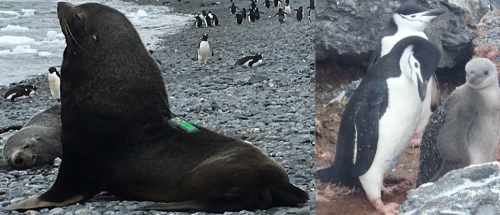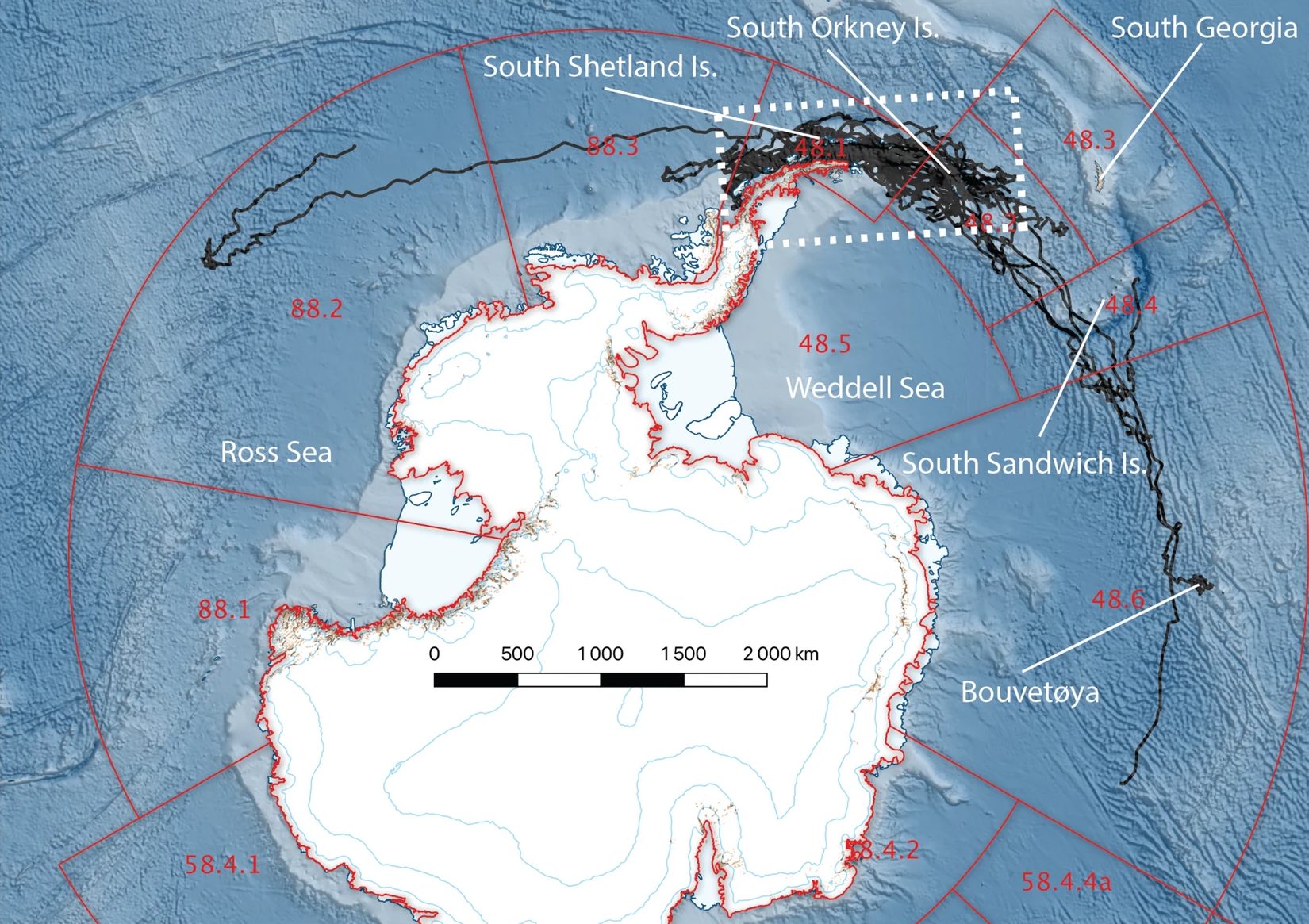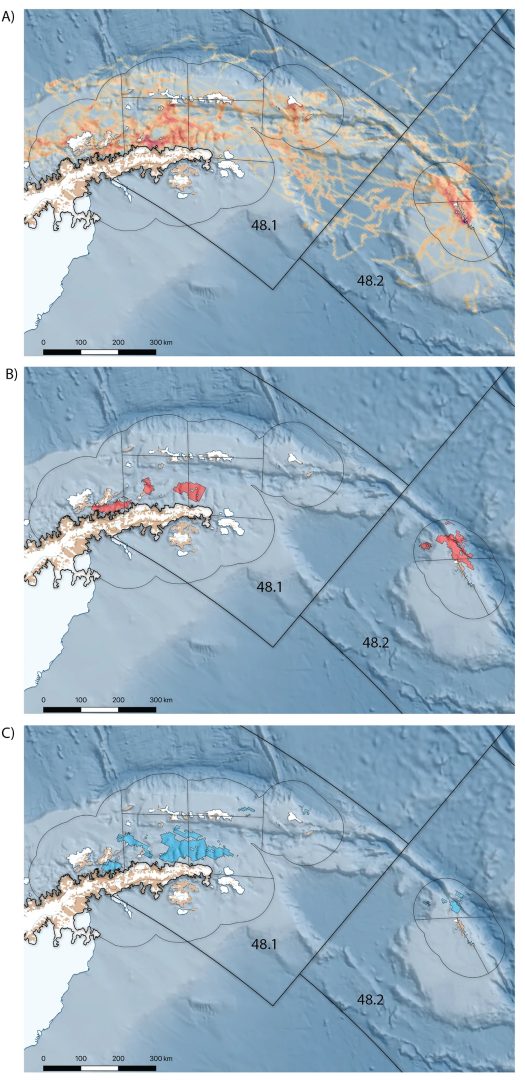← Back
How male Antarctic fur seals compete with fisheries and penguins for krill

Krill is at the base of the food-chain near Antarctica. It is also fished, with regulations enforced in regions where endangered species are also feeding on it. However, other species can also compete for this particular resource. Argos helps in assessing the foraging areas of male Antarctic fur seals, in expansion with respect to the fisheries ground and the locally breeding species such as chinstrap penguins.
The Southern Ocean underwent a severe depletion of its top predators in the nineteenth and early twentieth centuries, severely unbalancing the ecosystem. The top predators are now mostly protected and recovering (more or less). However, more recently the Antarctic krill (Euphausia superba) fisheries are aiming at one of the most important bases of the food chain in the regions. Moreover, some regions, like the western Antarctic Peninsula are undergoing rapid changes in the context of global climate change. Understanding the relations and competitions between the different predators and the fisheries for krill is thus important. We already mentioned studies on marine predators’ relations with fisheries in e.g., Argos helps in assessing fisheries bycatch risks to seabirds, but mostly under the angle of bycatches. Competition for resources between fisheries and marine predators, and indeed between different predator species, are also issues.
Monitoring krill predation & fisheries
Krill fisheries currently use two techniques, one older (trawls), less selective but also less efficient, than the newer one (continuous pumping). Those fisheries are regulated around Antarctica by the Commission for the Conservation of Antarctic Marine Living Resources (CCAMLR). The indices used in regulation monitoring are based on krill-dependent breeding species such as penguins (see Keith Reid, Penguins show the way for marine spatial planning or in Argos Forum 84 ), or female Antarctic fur seals (Arctocephalus gazella) and pups.
The Antarctic fur seal is one of the predator species living around Antarctica. Its diet heavily relies on Antarctic krill. Females take care of their pups for a time and thus do not roam very far. However, male Antarctic fur seals are abundant with an increasing population lately, and without constrains since they leave the land as soon as they have mated and do not care for the young (contrary to penguins and to the female fur seals). They constitute a potential important pressure on krill resources on a large scale not currently monitored.
Learn more about animal tracking with Argos
Tracking male Antarctic fur seals
Twenty juvenile, subadult and adult, male Antarctic fur seals were equipped early 2016 with Argos satellite telemetry PTTs which also recorded dive data. Most of the animals went into the Bransfield Strait (the strait between the West Antarctic Peninsula northern tip and the South Shetland islands) by late January. They remained there until the transmitters stopped functioning in late austral winter/early spring. Their at-sea locations were modelled so as to create a continuous movement path from which home ranges and core areas could be defined.

Argos satellite telemetry tracks from the 20 male Antarctic fur seals between 1st January and 8th December 2016 tagged at Powell Island, South Orkney Islands. Two animals ranged as far as the eastern Ross Sea and east of Bouvetøya in the Atlantic, though most remained within the Scotia Sea and western Antarctic Peninsula area. Key krill fishing grounds are shown as the white dashed box; red boxes are CCAMLR Subareas. From [Lowther et al., 2020]
Foraging areas and fishing grounds overlaps
On the krill fisheries side, the locations of the tows and the technique used are reported so can define their fishing grounds (assuming that they represent the true locations). Moreover, a number of studies on penguins using satellite telemetry – here chinstrap penguins (see Chinstrap penguins are spreading a long way around Antarctica)– exists with home ranges and habitat modelling defined for them. The overlaps between the male Antarctic fur seal, the krill fisheries (separating the two techniques), and the chinstrap penguins can thus be evaluated.
Most of the areas exploited by fisheries are within the modelled home ranges of the male Antarctic fur seals. However, the areas exploited by fisheries occupy less than 6% of male Antarctic fur seals home range during the study period (up to 18% considering the total distribution of the fishery between 2009-2018), even though those are the ones most intensively used. Moreover, the timing of potential competition and interactions may differ. While male Antarctic fur seals occupy home ranges throughout the Peninsula and Scotia Sea between January and October, the fishery has a seasonal pattern moving between the South Orkneys in the summer, Bransfield Strait in the autumn and South Georgia in the winter. Both the fisheries and seals also used the same depths of water, diving deeper in winter to find krill.
Complex interactions to take into account for an Ecosystem-Based Fisheries Management

(A) At-sea distribution of mean time spent within 5 km grid cells of the 18 male Antarctic fur seals which stayed near the West Antarctic Peninsula. (B) and (C) overlap between the home range of male fur seals and the areas where the commercial krill fishery operate (B) continuous pumping and (C) traditional trawling fishing gear. From [Lowther et al., 2020]
The interactions between fisheries and male Antarctic fur seals are thus different depending on the period of the year, of the fishing gear, throughout the West Antarctic Peninsula and Scotia Sea region. Moreover, it must be mentioned that the year 2016 was particular due to a strong El Niño. If you add chinstrap penguins in the analysis, the competition become even more complex. However it can be said that areas intensively used by both male Antarctic fur seals and the krill fishery around the South Orkney Islands overlap in space and time with the late stages of chinstrap penguin breeding, suggesting considerable competition between the three.
A substantial portion of the vessels within the krill fishing fleet are fitted with echosounders capable of providing near-real-time estimates of krill abundance and distribution. This provides an opportunity to adaptively scale catch to local krill availability, in order to prevent depletion in those areas. The most recent sophisticated modelling approaches and new information on the movement of previously unmonitored predators such as male Antarctic fur seals should enable to evaluate the demographic trends of chinstrap penguins taking into account cumulative, spatially heterogeneous competitive interactions between species and the nonlinear effects of climate change. A new Ecosystem Based Fisheries Management (EBFM) system for the Antarctic krill fishery could benefit from these studies.
Reference
Lowther, A.D., Staniland, I., Lydersen, C. et al. Male Antarctic fur seals: neglected food competitors of bioindicator species in the context of an increasing Antarctic krill fishery. Sci Rep 10, 18436 (2020). https://doi.org/10.1038/s41598-020-75148-9
Photos: Antarctic fur seal and chinstrap penguin with an Argos PTT (credit Andrew Lowther)



